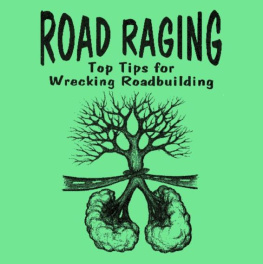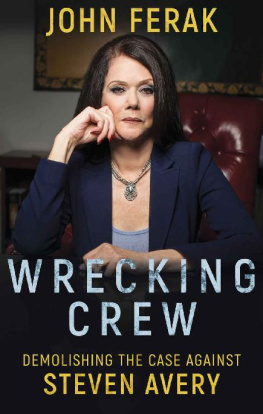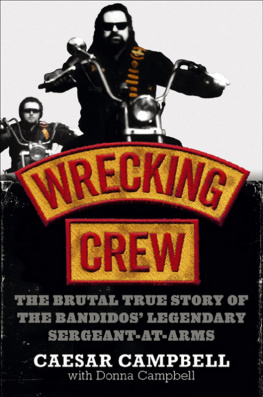RoadAlert! - Road Raging: Top Tips for Wrecking Roadblocking
Here you can read online RoadAlert! - Road Raging: Top Tips for Wrecking Roadblocking full text of the book (entire story) in english for free. Download pdf and epub, get meaning, cover and reviews about this ebook. publisher: eco-action.org, genre: Science / Politics. Description of the work, (preface) as well as reviews are available. Best literature library LitArk.com created for fans of good reading and offers a wide selection of genres:
Romance novel
Science fiction
Adventure
Detective
Science
History
Home and family
Prose
Art
Politics
Computer
Non-fiction
Religion
Business
Children
Humor
Choose a favorite category and find really read worthwhile books. Enjoy immersion in the world of imagination, feel the emotions of the characters or learn something new for yourself, make an fascinating discovery.
Road Raging: Top Tips for Wrecking Roadblocking: summary, description and annotation
We offer to read an annotation, description, summary or preface (depends on what the author of the book "Road Raging: Top Tips for Wrecking Roadblocking" wrote himself). If you haven't found the necessary information about the book — write in the comments, we will try to find it.
RoadAlert!: author's other books
Who wrote Road Raging: Top Tips for Wrecking Roadblocking? Find out the surname, the name of the author of the book and a list of all author's works by series.
Road Raging: Top Tips for Wrecking Roadblocking — read online for free the complete book (whole text) full work
Below is the text of the book, divided by pages. System saving the place of the last page read, allows you to conveniently read the book "Road Raging: Top Tips for Wrecking Roadblocking" online for free, without having to search again every time where you left off. Put a bookmark, and you can go to the page where you finished reading at any time.
Font size:
Interval:
Bookmark:
ROAD RAGING
Top Tips for Wrecking Roadbuilding
The intention of this guide is to suggest advice on building and maintaining a fluid direct action campaign, by sharing experiences learned from British anti-roads campaigns between 1992 and 1996. It contains ideas on building a campaign, dealing with the accelerating pace as contractors arrive, and practical tactics to stop them. Although we're dealing with roads, much of this is, of course, applicable to building resistance and fighting other types of destructive developments. Information on positive actions, such as "Reclaim the Streets" street parties, is also included.
We won't attempt to duplicate any of the several excellent existing guides on fighting road schemes at an earlier stage. We concentrate on the later stages, involving direct action - although getting in early is vital to win! See Chapter 17 for details of the relevant publications.
Although this guide is based entirely on British experience, and much of its content is specific to Britain, we hope that readers in other parts of the world will find things of interest and use in here as well.
The layout is roughly in the order a campaign might proceed, but as some will probably repeat what you already know, we have also tried to incorporate "dip-into-ability", with easily identifiable subject headings.
Please be aware that this book only represents the opinions of a few people. Direct action requires a questioning attitude and means thinking for yourself. We hope that this will at least be a starting point for ideas; don't stop here! Read and use the lists of contacts and resources in Chapters 16 & 17. In the Appendix we have also included examples of documents from previous campaigns, such as "Beat the Bulldozer" pledges, phone trees, and bust cards.
Good luck, and please keep in touch with any constructive feedback.

The general pattern of British anti-road protests has been separation into a "Lawful Campaigning" phase and a "Direct Action" phase. The stereotypical sequence would be: years of patient, energetic campaigning, lobbying and awareness- raising by dedicated locals; followed by a last-ditch, hectic and spectacular direct action frenzy as construction begins. This is, of course, a very superficial model, and many of those taking part in each phase will be the same people; but it remains true that there is far too much separation, on many levels, between "conventional" campaigning and direct action. One of the main themes of this guide is bridging the gaps.
It's easy to get hung up on definitions of "direct action", "civil disobedience" etc. (see below for a brief discussion). What matters is that the approach at any time should NOT be stereotyped, but should be determined by whatever seems most likely to delay or STOP THE ROAD. It can be surprisingly easy to lose sight of this objective! For example, if you have heard that roads are going to be cut in the Budget, your last 50 may be better spent targetting Treasury officials and MPs, than on buying D-locks. On the other hand, if the contract to build the road has been let, writing indignant letters to the government is a waste of time, that could be better spent building up camp defences, or finishing off the action phone tree.
Deciding what is and isn't appropriate for the campaign will take debate, argument and broad consensus. One of the main benefits of this sort of discussion is that people with different backgrounds can learn from one another, and that direct action tactics can be used in the campaign as and when required, rather than being artificially separate. It's a big mistake to assume that the spontaneity, passion and daring of good direct action should only be used in a limited section of the campaign, or only by a "special" group of activists.
Direct action is powerful and may benefit from careful planning. Consider things carefully and use it appropriately - but don't be afraid to go with your instincts. We'd definitely recommend starting cautiously and "escalating" tactics as time passes and the start of roadbuilding approaches.
This phrase has been applied to a huge variety of activities, and getting on and doing it is much more important than constantly arguing definitions! Briefly, direct action implies acting yourself, in a way that directly addresses the problem which you're confronting, and without relying on, or seeking approval from, politicians, bureaucrats or other mediators. Therefore, if you see bulldozers ripping apart somewhere you care about, you take direct action when you directly intervene to try and stop them.
Direct action also implies rejection of the procedures and rules of the roadbuilders, and having the initiative to decide for yourself what is right and what needs to be resisted, rather than obeying laws or orders. Although direct action can be seen merely as one tool in any campaigner's tool box, it is also much more than this. It means fighting for control of your own life and to attempt directly to affect the world around you, taking responsibility for your actions on your own terms.
In this guide we describe various direct action techniques, as well as ways to support, or build up to, direct action, and also more "conventional" campaigning methods. We don't see this as a hierarchy, but as a diversity without which a campaign will be one-dimensional, and unlikely to stop the road. Do what's right, do what's effective, and JUST DO IT!
The type of protest we will describe is generally called NVDA (Nonviolent Direct Action). It is impossible to adequately discuss the issue of nonviolence here, but a few points are worth making. Most activists would probably agree that British anti-road actions since Twyford Down in 1992 have been mostly nonviolent in character; however, it's important to state that definitions of "nonviolence" vary greatly, and there is a wide range of views. In particular, the right to defend oneself against violence is a controversial point. The people who wrote and edited this themselves differ in opinion on these issues.
Some activists see a nonviolent philosophy as absolutely essential at all times, and would not support any form of action which involved or supported violence; NVDA as both means and ends. Others see NVDA only as a tactic, and believe that violence may sometimes be necessary. It's probably fair to say that the majority of activists agree on nonviolence as the most successful and appropriate approach for fighting roadbuilding in Britain now; that's our view, at least. Therefore, the tactics and ideas outlined in the following pages are nonviolent ones. Ways of dealing with, and reducing, violent behaviour towards yourself are also discussed. (see Chapter 10).
The State has always depended absolutely on threatening and using violence, and will dig deeper into its huge arsenal given any excuses. It will nonetheless be quick to condemn any violence on your side - often including such actions as damage to property. The media will follow this line. It is important to expect this sort of thing and be ready to deal with it. Productive discussion within the campaign about nonviolence needs to happen if the campaign is to cope well with these issues.
It is important to recognise the various stages of roadbuilding to prepare to fight it. After the political decision to build the road has been announced, the first stage will be awarding of the preliminary contracts. (NB. A generalised sequence of a contract award is described in Chapter 7.) The roadbuilding agency will be busy trying to let these contract(s), so now is the time to attempt to sabotage the contracts procedure - see Chapter 10 for ideas.
Next pageFont size:
Interval:
Bookmark:
Similar books «Road Raging: Top Tips for Wrecking Roadblocking»
Look at similar books to Road Raging: Top Tips for Wrecking Roadblocking. We have selected literature similar in name and meaning in the hope of providing readers with more options to find new, interesting, not yet read works.
Discussion, reviews of the book Road Raging: Top Tips for Wrecking Roadblocking and just readers' own opinions. Leave your comments, write what you think about the work, its meaning or the main characters. Specify what exactly you liked and what you didn't like, and why you think so.












